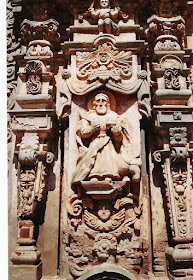We finish up our current series on the popular baroque churches of Puebla with a visit to the former Franciscan church of Santiago Apostol Chignahuapan near Zacatlan in northern Puebla.

The recently restored painted facade is another striking example of popular taste, framed by estípite inspired pilasters interspersed in folkloric style with colorful stucco reliefs of fruits and foliage.
Although the sculpture niches are currently empty, a dramatic painted equestrian relief of the militant patron Santiago adorns the crowning gable, mounted on his steed with flying cloak and banner.
In the nave stands a handsome gilded retablo, also fashioned in ornate late baroque style with estípite pilasters. Statues of Franciscan saints accompany the figure of the Archangel Michael in the upper niche, trampling the devil beneath his feet.
Although the sculpture niches are currently empty, a dramatic painted equestrian relief of the militant patron Santiago adorns the crowning gable, mounted on his steed with flying cloak and banner.
In the nave stands a handsome gilded retablo, also fashioned in ornate late baroque style with estípite pilasters. Statues of Franciscan saints accompany the figure of the Archangel Michael in the upper niche, trampling the devil beneath his feet.
text © 2019 Richard D. Perry
color photography © Niccolo Brooker and online sources.
Please review our earlier posts on the folk baroque churches of Puebla: San Jeronimo Aljojuca; Santa Inez Xanenetla; Tlancualpican; Santa Ana Jolalpan; Santa Maria Jolalpan; San Simón Quecholac; San Pablo de Las Tunas; Chiautzingo;
Please review our earlier posts on the folk baroque churches of Puebla: San Jeronimo Aljojuca; Santa Inez Xanenetla; Tlancualpican; Santa Ana Jolalpan; Santa Maria Jolalpan; San Simón Quecholac; San Pablo de Las Tunas; Chiautzingo;
















































